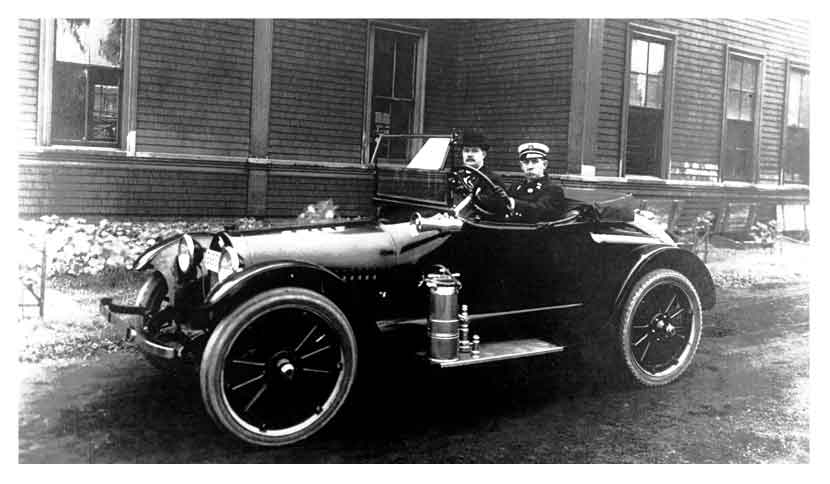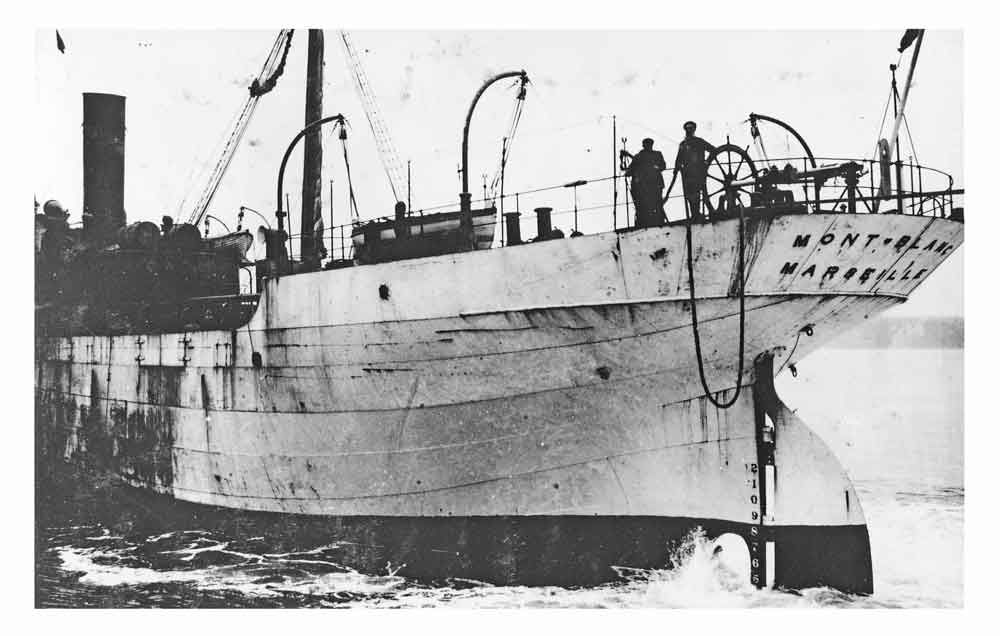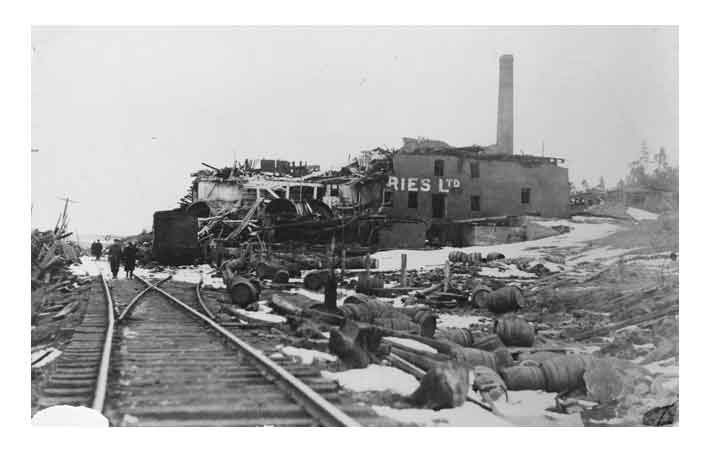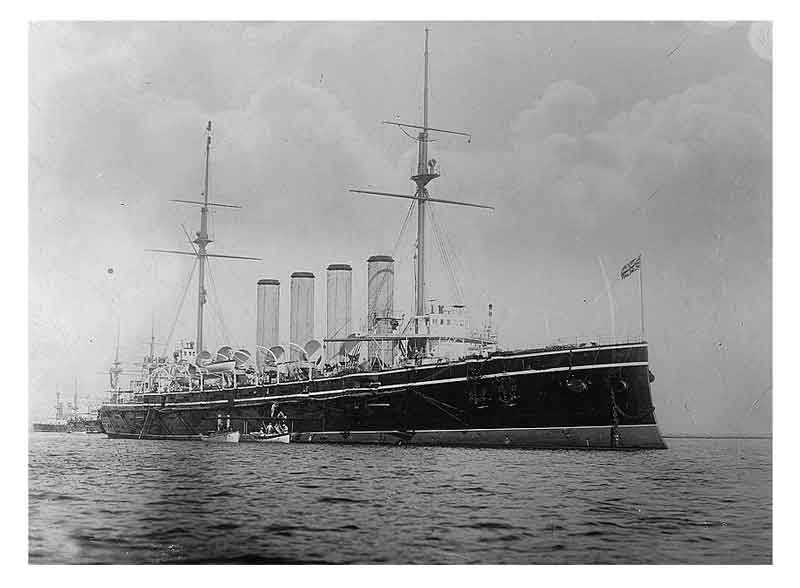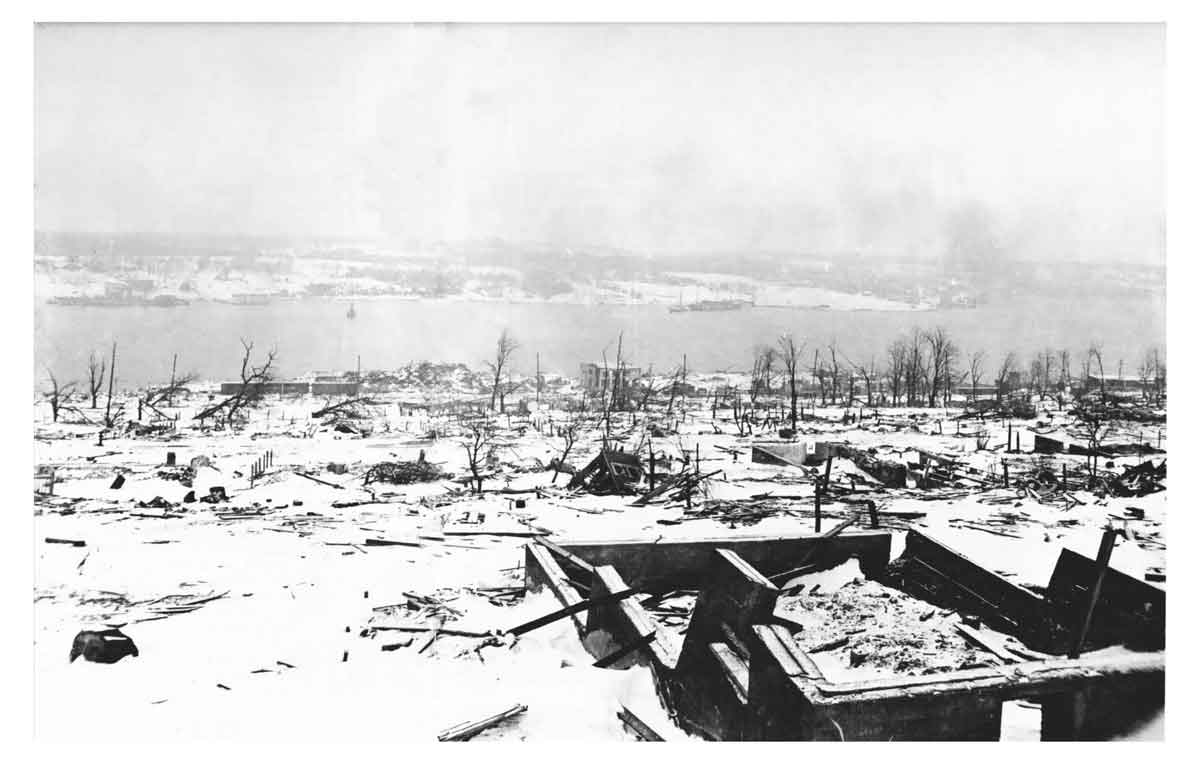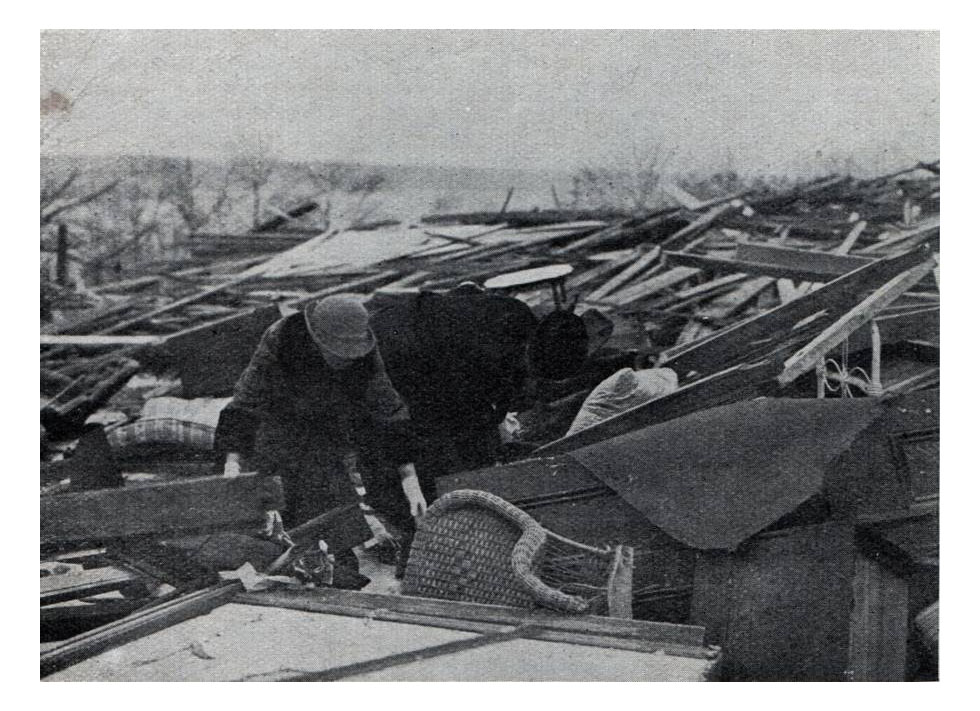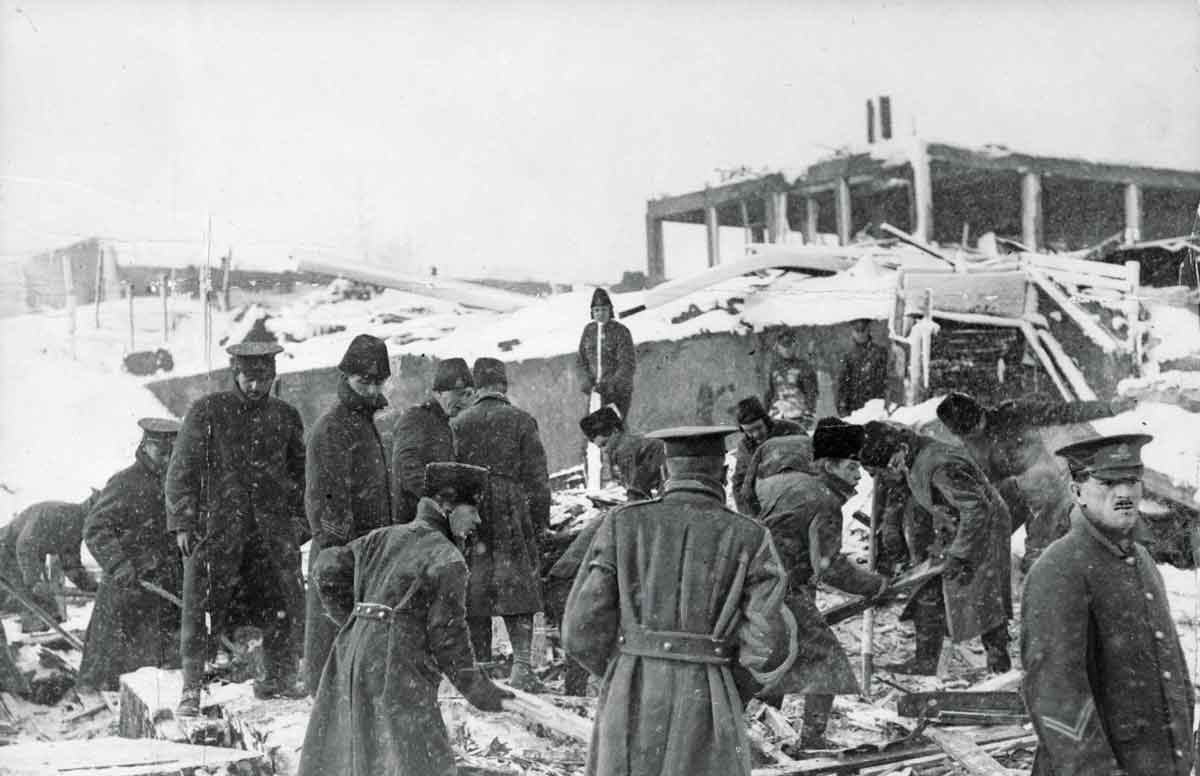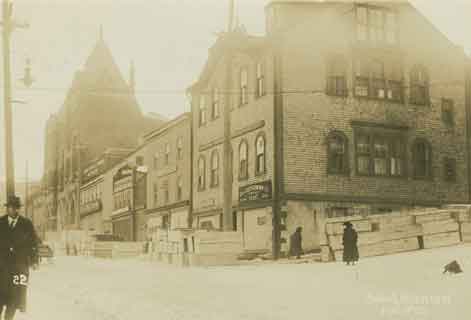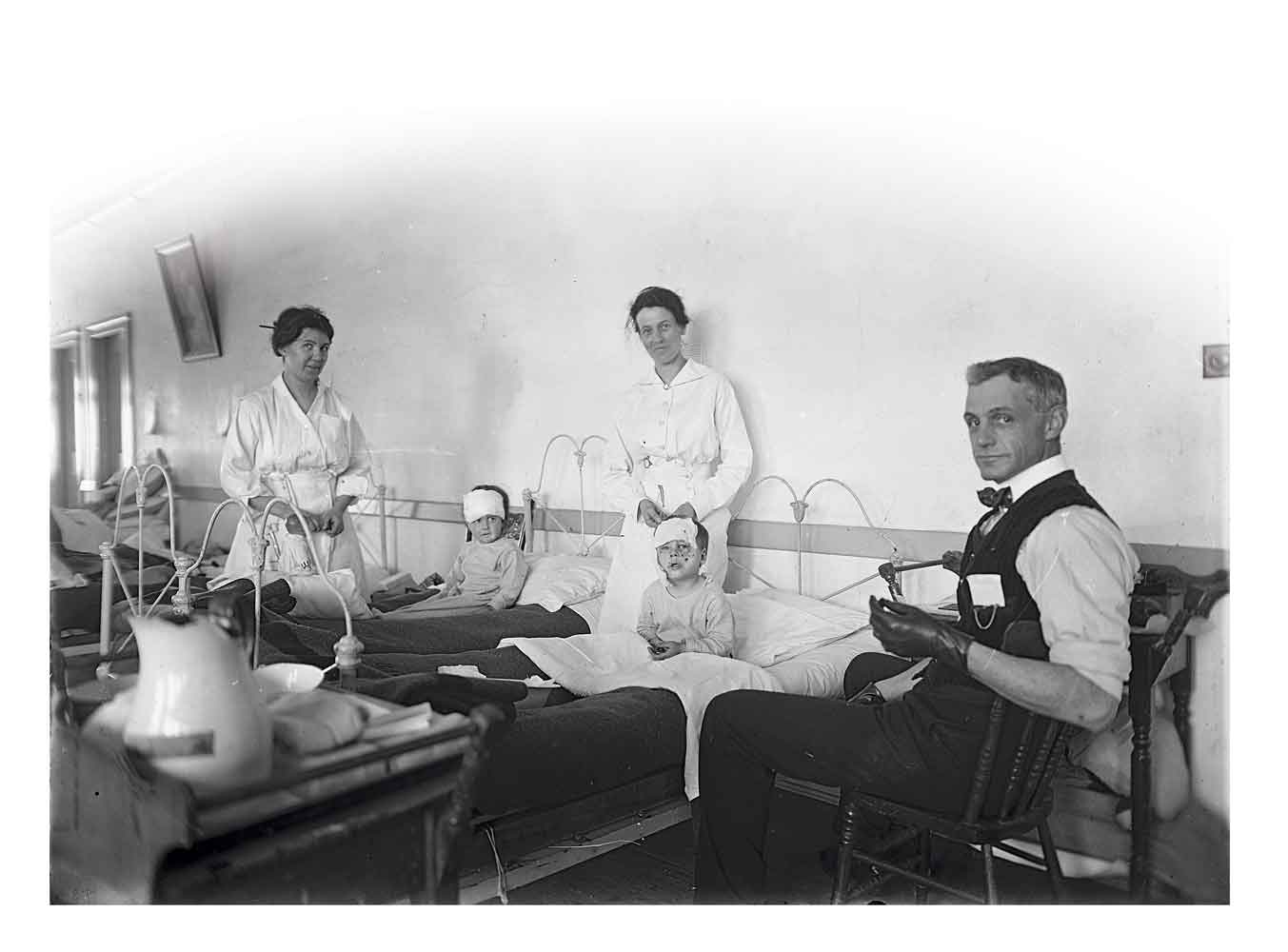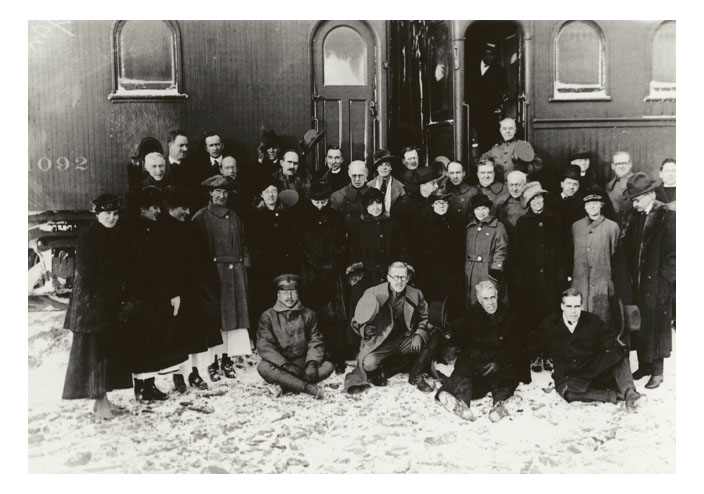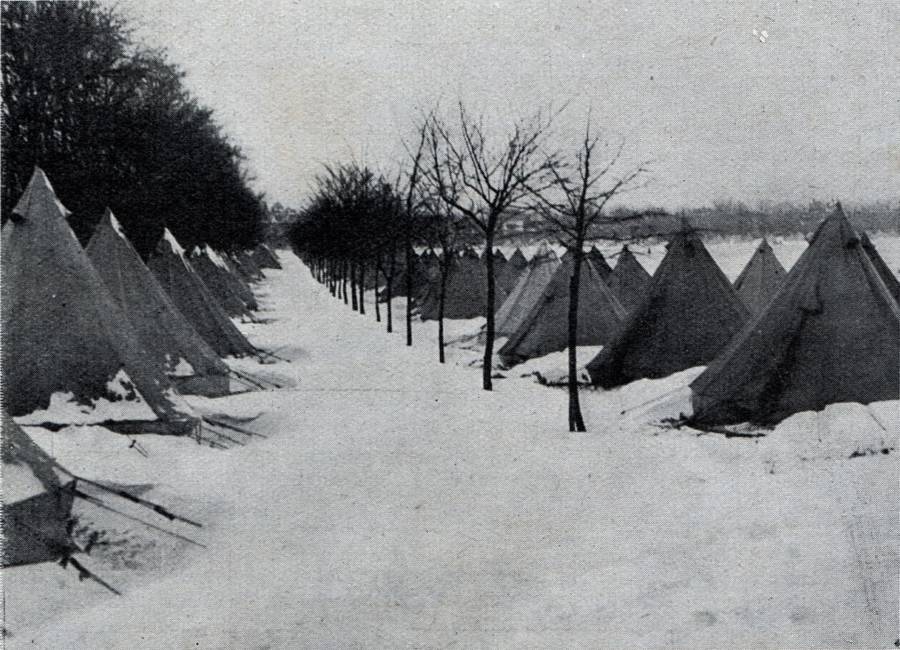Introduction
A collision between two ships in Halifax Harbour in 1917 set off an explosion unrivalled until the atomic bomb. An entire neighbourhood was destroyed, thousands killed and injured, thousands more left homeless. Army and navy personnel worked shoulder-to-shoulder with civilians on rescue, recovery and reconstruction.
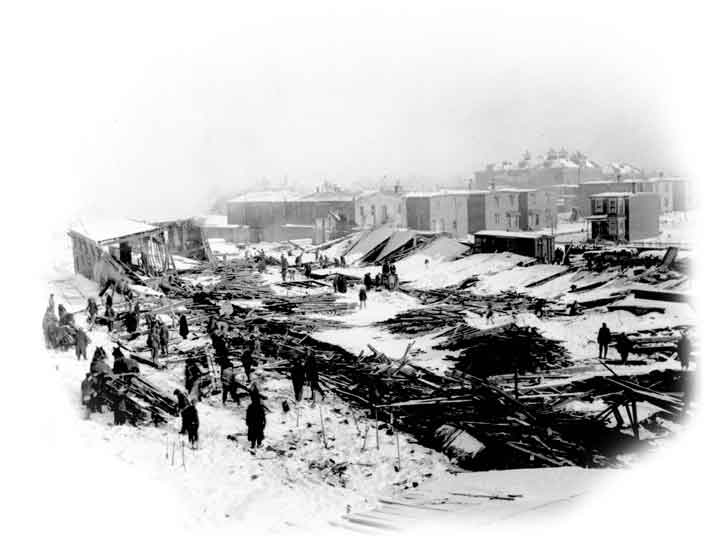
i
Rescuers and residents sift through collapsed buildings on Clifton Street in Halifax in the explosion’s aftermath. [Original photograph copied through the courtesy of Mrs. Shirley Vaughan. Charles Vaughan - Nova Scotia Archives / negative: N-7036]
Part I: The collision
The First World War turned Nova Scotia’s bustling port of Halifax into a boom town. Its ice-free harbour was the perfect departure point for ships carrying troops to Europe and the wounded back home, its secure Bedford Basin ideal for assembling convoys laden with war materiel for the front and relief supplies for civilians.
The permanent population swelled to 50,000 by 1917, in addition to thousands of temporary army and navy personnel at the garrison, navy yards and aboard ships. Many civilian newcomers drawn to work at the busy factories and foundries settled in the Richmond neighbourhood overlooking the bustling waterfront, convenient to workplaces and close to schools, churches and shops.
Halifax Population 1801–1901
40,000
30,000
20,000
10,000
Thursday, Dec. 6, 1917, dawned clear and crisp as residents of Richmond began their busy day. In the adjacent Narrows—the strait connecting Bedford Basin to Halifax Harbour—the Belgian relief ship SS Imo, outbound for New York to pick up cargo, and the French munitions ship SS Mont-Blanc, inbound to join a convoy headed for Europe, collided.
How Could This Happen?
December 1, 1917SS Mont-Blanc leaves New York heading to Halifax to join a military convoy. | December 3, 1917SS Imo arrives at Halifax for inspection and awaits clearance to continue on to New York to gather relief supplies. | December 5, 1917Imo is given clearance, but due to a delayed coal refuelling, is not able to depart before Halifax Harbour closes for the night. | December 5, 1917Mont-Blanc arrives at Halifax Harbour late and must wait overnight for the harbour to open and lower its anti-submarine nets. | December 6, 1917Imo enters the Narrows above the harbour speed limit in an attempt to make up for previous delays. | December 6, 1917Imo meets the steamer SS Clara travelling on the wrong side of the harbour and Imo is forced to move near the centre of the waterway. | December 6, 1917Soon after, Imo meets another ship, the tugboat Stella Maris, in the centre of the channel and Imo travels even farther east into the incorrect channel. | December 6, 1917Mont-Blanc spots the outbound Imo ahead and sends a warning signal using the ship whistle to indicate that Imo is in the incorrect channel. | December 6, 1917Imo returns back two whistle blasts to state that they will remain in their position and will not yield. | December 6, 1917Mont-Blanc halts their engine, moves to starboard and sends one last whistle as a final warning. | December 6, 1917Despite the efforts of the two ships, their hulls collide with enough impact to topple Mont-Blanc's containers of explosive materials. |
←
→
Mont-Blanc’s holds were stuffed with explosive trinitrotoluene (TNT), guncotton and picric acid, as well as highly flammable benzol in drums on deck. Yet it flew no flag to indicate it was a munitions ship, due to fear of attracting the attention of patrolling German subs.
The ship was a floating bomb, every substance in the cargo engineered to blow up, noted Laura M. MacDonald in Curse of the Narrows: The Halifax Explosion 1917. When the ships collided, Mont-Blanc’s hold was pierced, fire started and quickly spread, igniting vapours from the benzol. In minutes, the deck—and the drums of benzol—were engulfed in flames. When the benzol reached its boiling point, the drums began launching like a series of rockets into the air, trailing smoke and bursting into fire aloft.
People on land were drawn to watch the fireworks. Crowds gathered in the streets with a clear view of the harbour. People stood at the windows of homes, schools and workplaces, and climbed to rooftops for a better view as Mont-Blanc, flames shooting up 30 metres, drifted toward shore as a thick plume of black, oily smoke rose three kilometres into the sky.
Part II: The explosion
At 9:04 a.m., a massive explosion all but wiped out Richmond, wrecked houses in neighbouring Africville and across the harbour, heavily damaged Dartmouth and obliterated Turtle Grove, a small Mi’kmaq community.
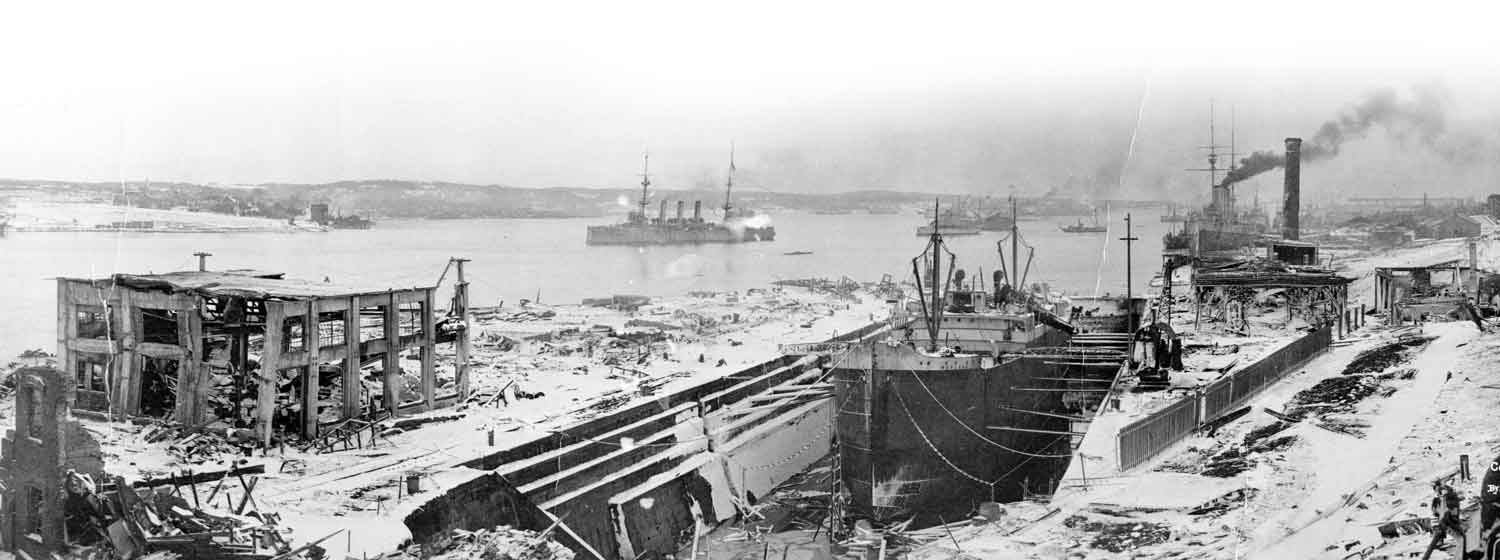
i
View from the destroyed north end of Halifax overlooking the harbour. [W.G. MacLaughlan/Library and Archives Canada]
The blast lifted the more than three-million kilogram Mont-Blanc 300 metres into the air, flung nearby tugs and ships onto the land and deposited several tonnes of rock from the harbour bottom onto the superstructure of one ship.
Much of Mont-Blanc became shrapnel. The shank of the anchor, weighing more than 500 kilograms, flew 3.5 kilometres. Smaller fragments fell in a deadly iron rain.

A supersonic blast wave killed more than 1,600 people instantly, destroying their internal organs or throwing them like rag dolls against brick and stone walls, fences and trees, or mortally wounding them with flying shards of glass, wood and metal. Buildings and houses were blown apart. Whole families were killed as their houses collapsed one storey onto another. People were crushed and battered and slashed, on the street, in schools and factories, foundries, breweries, rail yards and dockyards.
Sailors on ships in the harbour were killed by the dozen in a hail of white-hot shrapnel. Aboard HMCS Niobe, Seaman Bert Griffith saw Mont-Blanc vanish, then was hurled on deck and “saw something coming, can’t describe it… There was an awful noise, [then] all kinds of things falling. It was shrapnel and bits of the side of the ship,” he wrote in a letter to his wife, quoted by his grandson John G. Armstrong in a 1998 article in The Northern Mariner.
Even in Lawrencetown, 20 kilometres away, people “felt something like a blow in the face and then a sort of recoil or pull back in the opposite direction,” wrote Graham Metson in The Halifax Explosion: December 6, 1917.
A 5,000°C fireball vaporized water around the Mont-Blanc and created a six-metre wave that roared across the harbour, flinging ships out of the water and sweeping sailors to their deaths. It swamped the land, climbing about 18 metres above the high-water mark, drowning blast survivors and causing more buildings to collapse like grain before a gust of wind, as one witness described it.
For comparison: the
surface temperature of
the sun is 5,505°C.
1,600
HOUSES DEMOLISHED
9,000
LEFT HOMELESS
25,000
WITHOUT SHELTER
For 800 metres around the blast site, all the buildings were obliterated and everything within 1.5 kilometres was destroyed. The blast smashed railway cars and mangled the rails. Factories and foundries and houses collapsed. Farther away, roofs were torn off, chimneys collapsed. Glass shattered even in city neighbourhoods farthest away. In Truro, N.S., nearly 100 kilometres away, hotel windows were blown out, buildings jarred and items jostled from shelves. The explosion was heard in Charlottetown and on Cape Breton Island, nearly 300 kilometres distant—and far, far out to sea.
“All dwellings had been swept away,” wrote Metson, “and the streets were filled with the strangest apparitions: men, women and children with their faces…chalk-white with terror [or] black with the ‘black rain’ and smeared with blood. The dead, the dying and the severely injured lay about the streets, amid ghastly, bleeding fragments of what had been human beings’ heads and limbs.”
Along the shore “amidst the ruins wandered a few dazed creatures, blood-stained and in rags”—the few survivors of the military guard nearest the explosion, recalled Royal Navy Rear-Admiral Bertram Chambers, the port convoy officer, in an article in Naval Review.
First officer Charles Mayers of the cargo ship Middleham Castle had a lucky escape, relates MacDonald. He was blown off his ship, and when he came to, it was so black and wet he thought he was at the bottom of the sea. But he had come to rest atop a hill a kilometre away, soaked and wearing only his boots. The humid air inside the blast wave had condensed, drenching him with rain. He was among those few swept away in the explosion but saved by the city’s hilly geography: the force of the blast, strong enough to tear off clothing, was tempered by the hills. Although carried to a great height, some victims were relatively gently deposited on hilltops, rather than plummeting the whole distance they had risen.
Others were not so lucky. More than 80 crew of cargo ships Curaca and Calonne, loading horses at piers 8 and 9, were killed, as were nearly 70 aboard the SS Picton at the sugar refinery wharf. Forty-five died when Curaca was flung across the harbour by the six-metre tsunami. Nearby schooners were obliterated.
Workers who survived the blast rushed home only to find their houses gone, loved ones dead, dying, injured or missing. In the wreckage, coal- and wood-burning stoves had toppled and embers from furnaces scattered, setting houses and buildings afire.
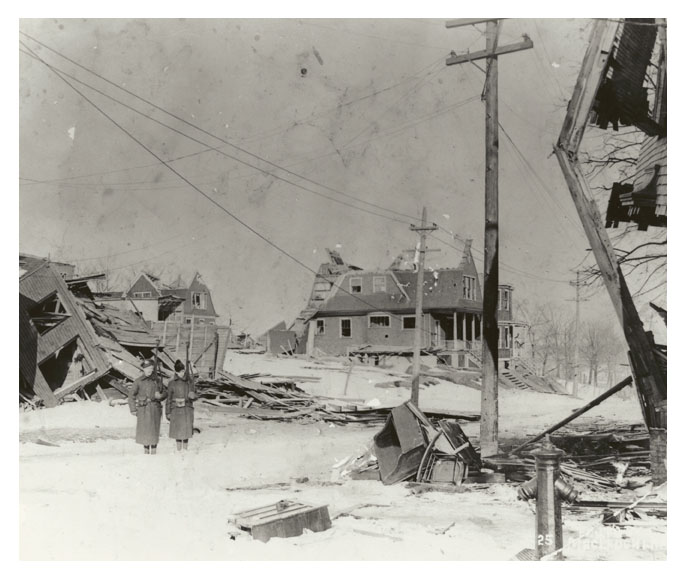
i
Soldiers stand guard near collapsed houses on Kaye Street after the Halifax Explosion.
[Halifax Relief Commission Nova Scotia Archives accession no. 1976-166 no. 36 / negative: N-2303]
“It is beyond me to describe the absolute terror of the situation,” wrote HMCS Acadia sailor Frank Baker in his diary, recently donated to the Dartmouth Heritage Museum. “For miles around, nothing but a flaming inferno.”
“Fires broke out on ships all around and hundreds of small crafts had been blown to hell. The sea presented an awful scene of debris and wreckage,” wrote Baker. “What…had been beautiful vessels were now terrible wrecks, their crews all dead and bodies, arms, etc. were floating around in the water.”
PART III: The rescue
All but one of the first responders from the fire department were killed, and their equipment was demolished in the blast, severely hampering the ability to fight the fires.
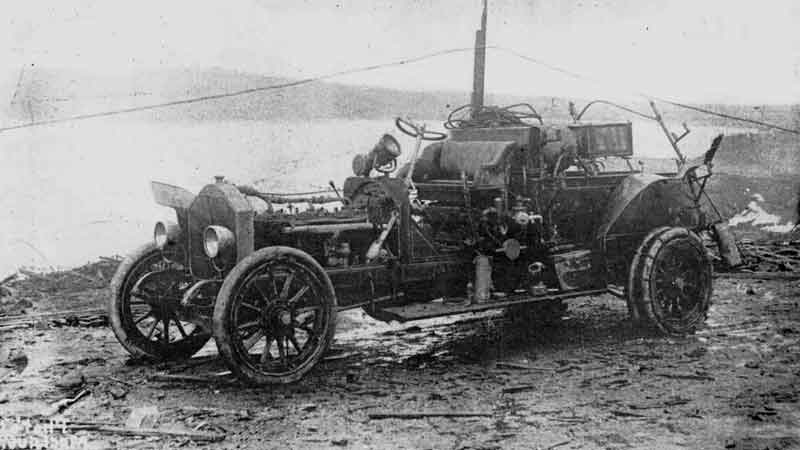
i
The remains of an American LaFrance pumper fire truck.
[Halifax Firefighters Monument Committee]
But the stunned populace, soldiers in garrison and sailors on ships, many of whom initially thought the Germans had attacked, reacted quickly to the crisis. The unharmed and the walking wounded flocked to Richmond to help the injured, dig out those trapped in ruins, and stop the fires from spreading.
The city was in chaos. The north end gas main was closed to prevent it from catching fire and exploding, electricity was cut off, and phone and telegraph lines were down. Streets were filled with rubble and glass that shredded tires. Families were separated as members pulled individually from wreckage were sent to different hospitals and frenzied spouses, parents and children searched for each other.
Canadian, British and American navy personnel sprang into action, seeing to their own wounded and sending surgeons, medical teams and work parties ashore to help. Sailors searched door-to-door and carried the injured to hospital. Those with first-aid training responded to a school to care for injured children.
The Canadian Army Medical Corps helped American navy personnel convert the USS Old Colony into a floating hospital, and sailors sent ashore returned with injured. HMS Changuinola sent out rescue and work crews. The ship’s lieutenant rounded up four cutters to take the injured by water to docks closest to hospitals and soon tugs were doing similar duty, wrote Joseph Scanlon in an article in The Northern Mariner
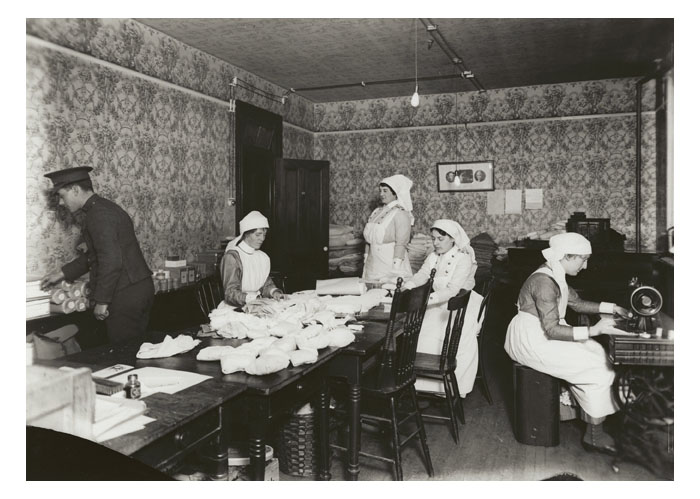
i
Preparing medical supplies for emergency relief.
[City of Toronto Archives (2439).]
Quick action prevented munitions on other ships and ashore from exploding. Lieutenant C.A. McLennan found live coals scattered from a furnace had started a fire in the heating house adjacent to the Wellington Barracks’ magazine. He put it out himself, but the resultant steam and smoke were mistaken as a fire. Panic ensued and thousands of people headed for open ground, setting back rescue work by hours. McLennan also put out other small fires and removed combustibles in the magazine itself, eventually aided by another soldier and crewmen from Changuinola.
Picton’s survivors had been taken to hospital, but marine superintendent Captain James Harrison headed for the ship, knowing 1,300 tonnes of munitions were still in the hold and that fire was consuming the nearby sugar factory. When he arrived aboard, Picton’s bow was metres away from a burning pier and the bridge was on fire. He put out the flames and ordered tugs to pull the ship away from shore.
The stricken Calonne, with its cargo of ammunition, was also towed away from shore. Some crews flooded their ships’ magazines. Niobe sent crews to clear the naval magazine ashore.
“We worked like slaves, pulling out cases of cordite and shells of all kinds and dumped them in the water,” said Gunner William O’Reilly, quoted in Armstrong’s Northern Mariner article. “It was a perfect miracle they did not go off, as the three buildings where they were stored had been completely wrecked, but luckily had not caught fire.”
With the railway telegraph down, George Graham, head of Dominion Atlantic Railway, and W.A. Duff, a civil engineer with Intercolonial Railway, knew the only way a message about the disaster would get out was if they walked to the nearest undamaged station. They arrived separately at Rockingham Station on Bedford Basin. Each wired their headquarters to send trains with doctors and nurses as soon as possible.
Unknown to them, help was already on the way. Canadian Government Railways dispatcher Vince Coleman, who was killed in the blast, had sent a warning to Truro to delay trains. His message was relayed to stations along the line. When the telegraph line went dead and the blast was felt in Truro, an emergency train was assembled, carrying doctors, nurses and volunteer firefighters. It picked up volunteers at each community along the way, and arrived shortly after noon. Before noon, trains had also left from Kentville, New Glasgow and Moncton, N.B., which sent another train at 1 p.m. and a third at 3 p.m.
Morse Code
Part IV: The military
As the initial response played out, deputy mayor Henry Colwell (the mayor was out of town) knew help was needed to organize rescue efforts and make longer-range plans for survivors, soon to face the privations of winter. And to identify and bury the dead.
Colwell turned to the military; 5,000 army personnel were stationed at the garrison, and there were hundreds of naval crew on ships and shore.
“For the Garrison, the explosion was in some ways their finest hour…and they proved their mettle under conditions as trying as anything experienced by their battle-hardened comrades,” wrote James F.E. White in The Garrison Response to the Halifax Disaster, 6 December, 1917.
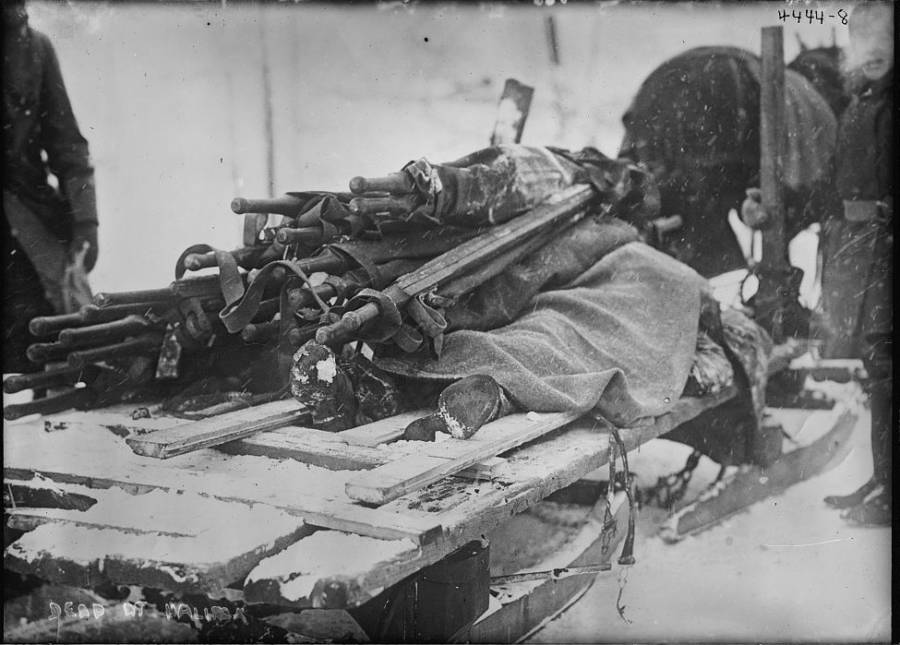
i
Bodies removed from the rubble are transported to morgues by sled.
[Library of Congress / LC-B2- 4444-8]
Colwell appealed to Colonel W.E. Thompson, commander of the No. 6 Military District Headquarters, who immediately ordered tents to be set up to accommodate survivors and sent soldiers out to help with rescue efforts. Within the hour, troops were distributing blankets to warm the naked and wounded, providing axes and shovels and labour for the rescue effort, and later commandeering vehicles for hospital runs.
Soldiers and sailors, many themselves injured, working “in utter disregard for their own safety, immediately started pulling people out of the ruins of their homes,” a soldier from Philadelphia, in Halifax to volunteer for the Irish Guards, recalled in The Garrison Response. Not one in his group needed a command “to go to the rescue of their fellow human beings in that hour of dire disaster.”
Early in the afternoon, extra help arrived from the Americans: the mushroom cloud had been seen more than 50 kilometres at sea, and US ships Tacoma and Von Steuben rushed to help. Their captains volunteered their 1,200 men for rescue, relief and guard duty.
Carl Moulton was among 150 army recruits immediately marshalled for rescue work, as reported in John G. Armstrong’s The Halifax Explosion and the Royal Canadian Navy: Inquiry and Intrigue. “We worked among the ruins for hours, had to improvise stretchers and take the injured to tugs and other boats to be carried to the hospital ships…. There was little confusion, for the military took hold of the situation,” he wrote to his girlfriend who was back home in Connecticut.
To thank the Boston Red Cross and Massachusetts for their generous relief efforts in 1917, Nova Scotia sent a Christmas tree to Boston in gratitude. Another was sent in 1971 and every year since. It is a tradition of goodwill, friendship and remembrance.
“Wherever there were soldiers, there was organization,” wrote Metson, who reserved his highest praise for those convalescing from the battlefields of Europe. “They gave up their beds in the hospitals and served as nurses and stretcher-bearers. Men who were not fit to work at all ‘carried on’ until they literally dropped.”
Overnight, a blizzard hit, leaving snow in waist-deep drifts. “Troops now had the added tasks of shovelling snow to try to keep a passageway open and of digging through deep drifts covering the ruins to find what lay underneath,” wrote Janet. F. Kitz in Shattered City: The Halifax Explosion and The Road to Recovery. Troops were assigned to recover bodies well into January. They also did guard duty, strictly controlling who was allowed into the devastated area, and were instructed to shoot looters.
As these events played out, longer-term plans were being made. Colwell, police chief Frank Hanrahan, former mayor Robert MacIlreith, Lieutenant Governor MacCallum Grant and others in public office met at 11:30 a.m., just two hours after the explosion. They established committees to handle transportation, food, shelter, donations, reconstruction—and began work that day. The Halifax Relief Committee was formally constituted on Dec. 9, eventually overseeing a dozen subcommittees.
The shelter committee opened an office at city hall to match those needing and those offering accommodations, and committee members began patrolling for people in need. The finance committee secured a line of credit at the Bank of Nova Scotia, which eventually donated $100,000 to the relief fund (worth approximately $1.9 million today). A food bank was set up at city hall.
The mortuary committee was headed by MacIlreith, who had been in office when the city dealt with the identification and burial of victims of the RMS Titanic’s sinking five years earlier. The committee was set up in a damaged school after military engineers had cleaned up the debris and covered the broken windows. Later, military personnel were tasked with cleaning the faces of the dead so they could be identified, and digging graves in the cemeteries. The Princess Louise Fusiliers played the funeral march on Dec. 17 at the burial of several unidentified dead.
Civilian and military officials worked together from the start. A city council meeting at 3 p.m. on the day of the blast was attended by garrison commander Major-General Thomas Benson and Rear-Admiral Chambers, the port convoy officer.
The conference was “held in the shattered town hall amidst splintered woodwork and floors covered with broken glass,” Chambers reported to the admiralty. Some of those present “had been at work since the explosion without even an opportunity to ascertain whether their nearest and dearest were in safety.” He left the meeting with the impression that “what could be done would be done.”
Part V: The hospitals
The legion of injured posed an immediate problem. The area’s four civilian and four military hospitals, as well as seven private hospitals and infirmaries, were almost immediately overwhelmed, despite the help of surgeons and medical teams from ships in the harbour and local doctors working in their own homes, stitching, tending burns, setting broken bones and other procedures.
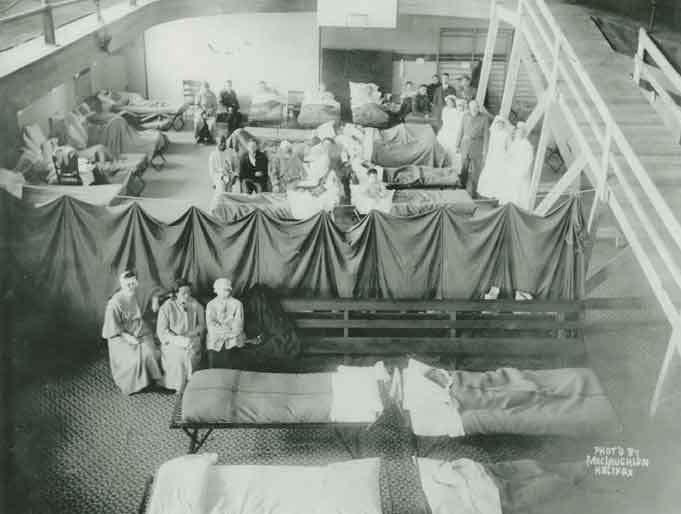
i
An emergency relief hospital was set up in the Y.M.C.A., Barrington Street, Halifax
[Lola Henry / Nova Scotia Archives / negative: N-7024]
Anyone with first-aid knowledge was pressed into service. Crew and passengers from the newly arrived overnight train from Saint John, N.B., used emergency tools to dig people out, water from the engines to wash wounds and sheets from sleeping cars as bandages. When the train pulled out again at 1:30 p.m., it was filled with injured evacuated to Truro.
“Management of the wounded...was a triumph for the Military Medical Service in Canada,” wrote Sir Andrew MacPhail in his 1925 official history of the service. “All military hospitals were instantly opened to civilian patients and the district medical stores supplied every need.”
Within 10 hours, wrote MacPhail, army engineers, the ordnance corps and medical service personnel, with help from American sailors, transformed an officers’ mess into a fully equipped hospital for the Massachusetts Medical Unit of the U.S. National Guard. It even had a kitchen. Such co-operation similarly transformed the USS Old Colony into a floating hospital; its surgeons treated 150 on the first day.
After a tour of the wreckage, military engineer Colonel Paul Weatherbe established dressing stations, a dispensary and a medical supply depot (subsequently managed by the Red Cross).
Lieutenant-Colonel Frank McKelvey Bell, chair of the medical relief committee, told a reporter he had never seen anything on the battlefields of France to compare with the devastation in Halifax. He was with the first medical unit to serve in France, and was experienced in working during emergencies. He oversaw the establishment of emergency hospitals by the Canadian Army Medical Corps, the distribution of military medical stores, and a system for allocating patients to hospitals. Within the first 48 hours, Bell later reported, “practically every patient in the city, in hospital or in houses, had received at least some medical care.” Camp Hill Hospital alone admitted 1,400 patients on the first day, although it had only 280 beds, reported Bell—and it still had nearly 350 patients on Christmas Eve.
Part VI: The aftermath
Emergency shelters were urgently needed, especially as temperatures started to plummet with the overnight blizzard. In some hospitals, whole families shared a mattress, while some people slept on the floor under beds. Friends, relatives, neighbours and strangers opened their doors to the homeless.
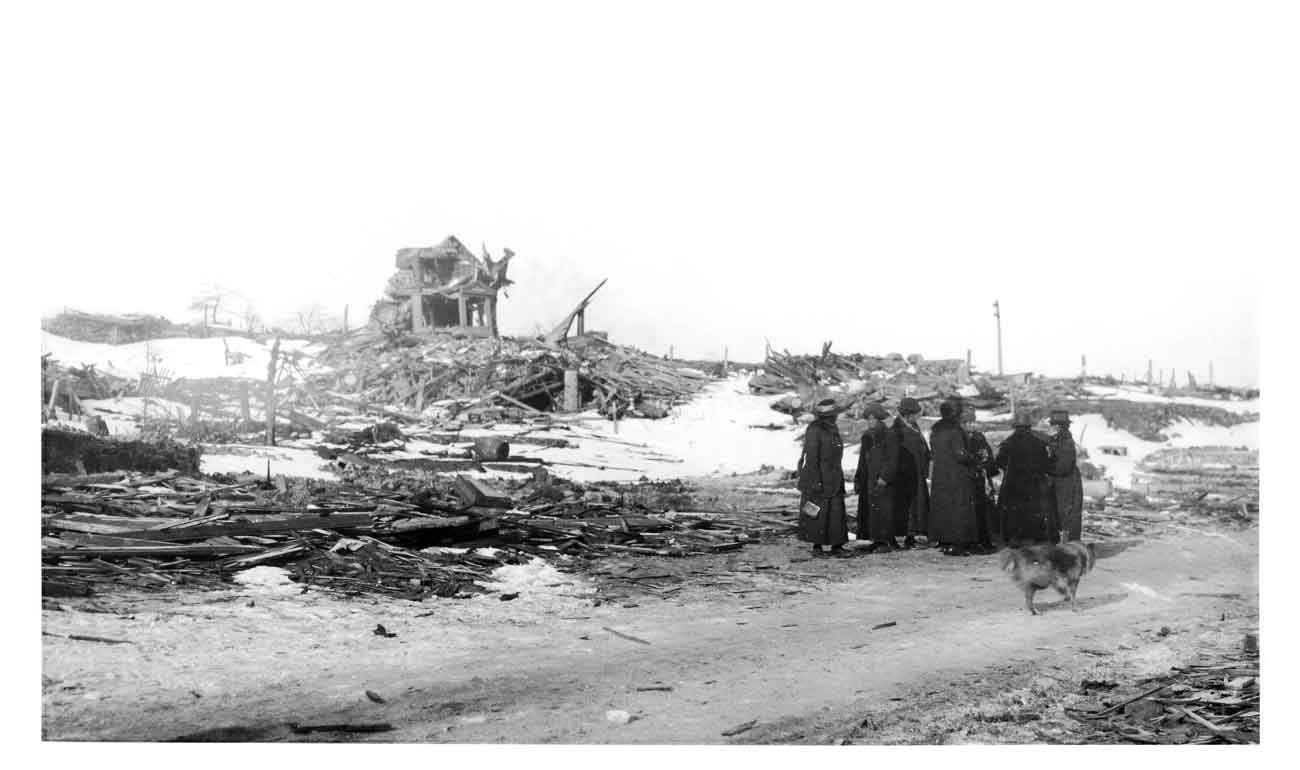
i
Women from Africville survey the damage.
[Nathaniel N. Morse / Nova Scotia Archives / negative: N-7080]
Along with all the medical volunteers and donated supplies, 40 cities offered shelter for the homeless, and donations of goods and money poured in. The Halifax Relief Commission, established by the dominion government under the War Measures Act in January, handled nearly $30 million (worth half a billion dollars today) in financial donations, including $18 million from the Canadian, British and American governments. Money poured in from other countries and provinces and from states, cities, towns, villages and individuals.
Food for the soup kitchens came in from farms and restaurants. Everything needed to re-establish a household— stoves and furnaces, clothing and furniture, linens and cutlery`—were donated. The Halifax-Massachusetts Relief Committee warehouse and Sir John Eaton’s supply depot gave the dispossessed free supplies.
Experienced in military camp construction, Colonel Robert Smith Low, soon to head up the reconstruction committee, was tasked with emergency repairs and providing temporary accommodation. Military and civilian crews worked feverishly in the cold to repair houses that could be inhabited and build emergency shelters. The military commandeered supplies of tarpaper, used to cover gaping windows, to prevent profiteers from buying it all up, thus ensuring it was fairly distributed. Military and civilian crews covered windows with tarpaper and beaver board and installed glass once it became available. A sash and door factory 65 kilometres away in Windsor, N.S., was taken over by military engineers to facilitate quick delivery of windows to Halifax.
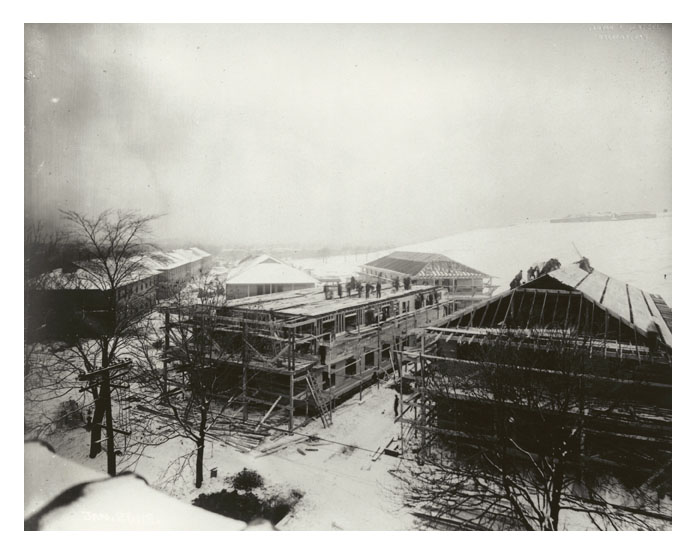
i
Offices under construction for the Halifax Relief Commission near Sackville Street and Bell Road.
[Halifax Relief Commission Nova Scotia Archives accession no. 1976-166 / negative: N-6265]
Low appealed to anyone who had worked with him building army camps in Quebec, Manitoba, Ontario and Alberta to come help with reconstruction work. Soon he was head of an army of tradesmen who managed in one month to put up 44 buildings containing nearly 400 apartments—enough to house nearly 1,000—with more to come.
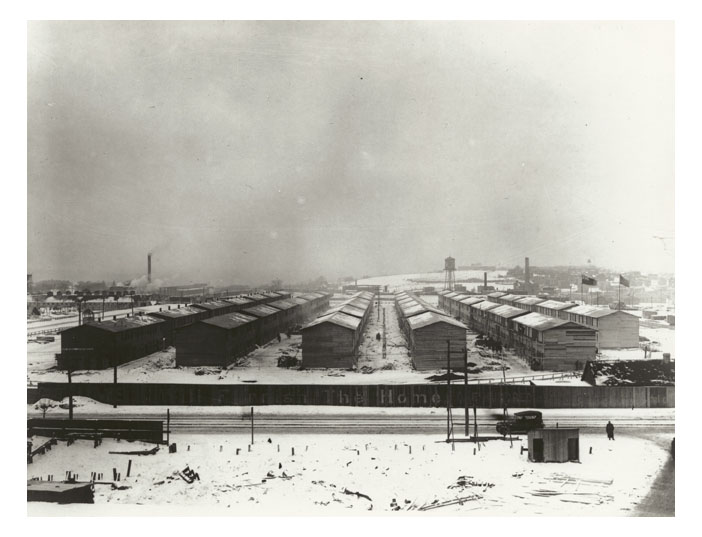
i
Temporary housing under construction near Almon and Robie streets.
[Charles Vaughan / Nova Scotia Archives / negative: N-7046]
It took years to rebuild the neighbourhood (no longer called Richmond); its destroyed houses, businesses and factories had to be reconstructed and—often—relocated. It was a massive job requiring effort of individual citizens, local businesses and every level of government.
Permanent replacement of destroyed military and naval buildings was also slow, but emergency repairs and construction happened quickly, because the port was too valuable for the war effort to be out of commission for long.
A funeral was held for soldiers and sailors on Dec. 11, just before the first convoy for the front, originally scheduled to leave the day after the explosion, sailed, escorted by Highflyer.
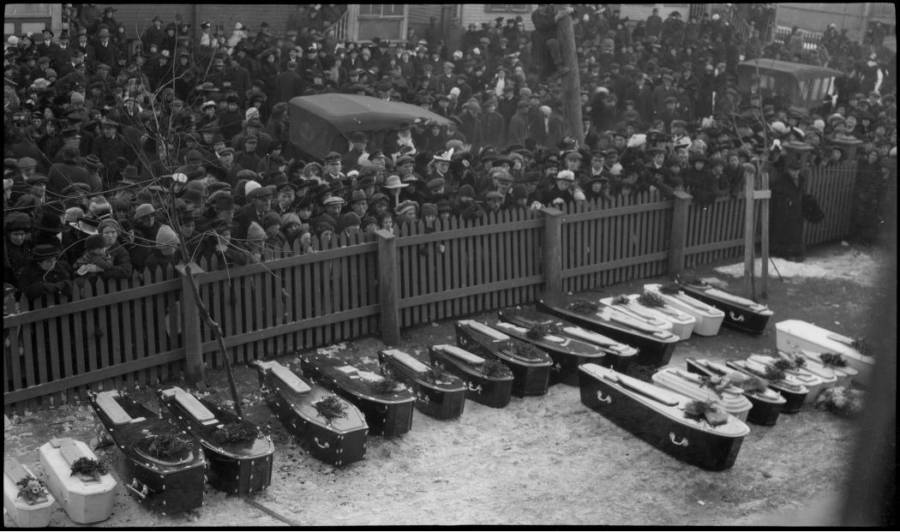
i
Funeral services for the unidentified bodies drew thousands of mourners.
[City of Toronto Archives]
Those first 10 days of rescue and recovery efforts were practically superhuman, but much more lay ahead before Canada’s most important wartime port would be fully functional again. As sailor Bert Griffith wrote to his wife on Dec. 16, “We’ll be working pretty near night and day for a long time yet.”
The scars remain to this day: in monuments to victims peppering the city, and the sorry harvest of metal and glass from gardens and construction sites.
